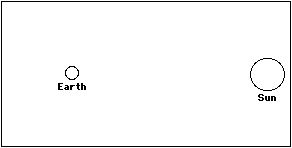
MMMM - Mercury
Use the diagram below to help explain why Mercury is always found close to the Sun in the sky. Simply drawing the diagram appropriately is not a sufficient answer!

--
Even without directly sampling the surface of Mercury, we can tell purely by observation what is its age relative to the more densely cratered lunar highlands.
a) (4 pts) Is the surface of Mercury (older than, younger than, same age as) the lunar highlands?
b) (8 pts) Explain your answer to part (a).
--
Unlike the Earth, Mercury has no moon, yet Mercury still suffers from tidal forces.
a) (4 pts) Are there tidal bulges on both sides of Mercury?
b) (8 pts) Explain your answer to part (a).
--
One theory about Mercury’s enormous cliffs is that they formed when the planet shrank due to cooling and slowing rotation.
a) (6 pts) Describe what caused Mercury’s rotation to slow down.
b) (6 pts) Why do we doubt this theory?
--
Unlike the other three terrestrial planets, which all have atmospheres of varying levels of thickness, Mercury has no atmosphere at all. Name and explain two reasons why Mercury has no atmosphere.
--
Early on during the formation of the solar system, the inner portion of the solar nebula disk was much hotter (in the region where Mercury would eventually form) relative to the portion further away (in the region where Earth would eventually form).
a) (7 pts) State briefly how the composition of the Earth differs from that of Mercury. Explain why this temperature difference may have led to Mercury's composition being much different from that of the Earth.
b) (7 pts) Today, Mercury's location in the solar system gets much more energy from the Sun (according to the inverse square law) compared to the Earth. Explain why this fact makes it much less likely for Mercury to retain an atmosphere.
--
Unlike the other terrestrial planets, Mercury has a consistency of almost pure metal (instead of a mix of rock and metal). One proposed reason for this is that Mercury formed near the forming Sun, where only metallic elements could condense into solids in the very hot part of the solar nebula.
a) (6 pts) An alternative theory to explain Mercury's composition involves a giant impact. Briefly discuss how this theory explains the origin of Mercury.
b) (8 pts) Although Mercury's composition is largely metallic, Astronomers didn't predict that Mercury would have a significant magnetic field. Name and explain two reasons why they made this prediction.
--
Mercury’s interior remains a mystery to Astronomers, despite decades of study. We know that it is metallic based on its density, but we are not sure why it has such a rich proportion of metal relative to the other terrestrial planets or why it seems to be at least partially molten in its interior.
a) (8 pts) Name and briefly explain two theories that explain how Mercury came to have such a high density relative to the other terrestrial planets.
b) (6 pts) Name and briefly explain two pieces of evidence that seem to indicate Mercury’s interior is partially molten (you do not need to discuss why it is molten).
--
The planet Mercury is composed almost entirely of metal, a fact that can be explained by one of three different formation theories: condensation, giant impact and evaporation. The Mercury Messenger (MM) mission proposes to make observations that will allow Astronomers to determine which of these theories is likely to be the most accurate. In a sentence or two, describe how the MM spacecraft will determine the composition of Mercury's surface, then pick two different theories out of the three possible and name and explain what observations made by the MM would support these each of these two theories.
--
If a giant comet struck Mercury tomorrow and immediately vaporized, Mercury would have an atmosphere consisting largely of water, Carbon Dioxide and Hydrogen gas.
a) Which would be the most likely to escape?
b) Explain the reasoning behind your answer.